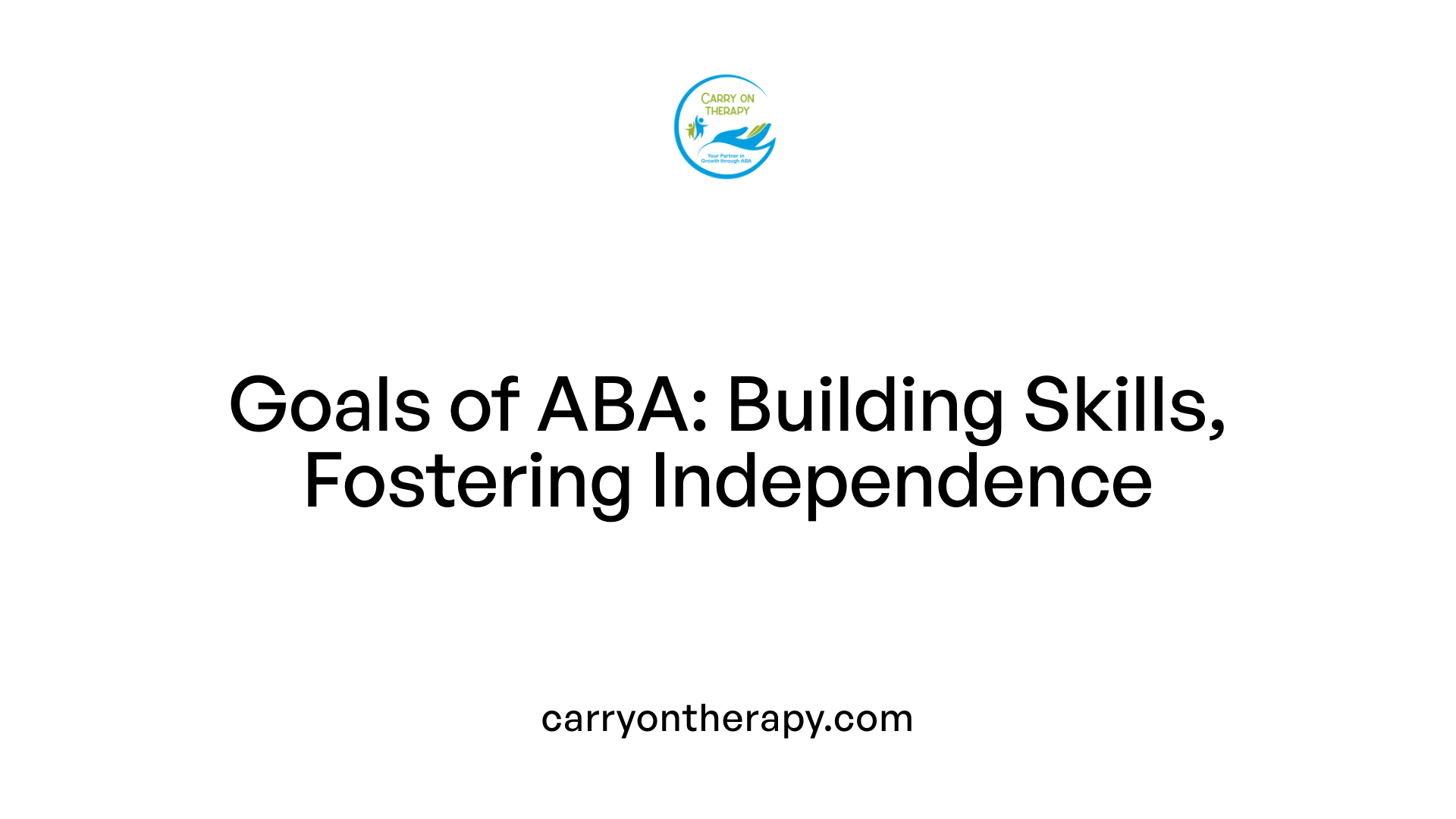ABA for Autism and Development Delays
Unlocking Potential: How ABA Therapy Transforms Lives of Individuals with Autism

Understanding ABA Therapy for Autism and Developmental Delays
Applied Behavior Analysis (ABA) therapy stands as a scientifically backed approach widely recognized for supporting individuals with autism and developmental delays. Rooted in learning theory and behavioral science, ABA helps shape behaviors by leveraging environmental influences and rewards, aiming to foster meaningful skills and greater independence. This article explores the principles, goals, providers, effectiveness, and broader context of ABA therapy, illuminating how this evidence-based intervention contributes to enhancing the lives of those on the autism spectrum.
What is Applied Behavior Analysis (ABA) Therapy?

What is Applied Behavior Analysis (ABA) therapy and how is it used to support individuals with autism?
Applied Behavior Analysis (ABA) therapy is a scientific approach based on learning theory and behavior principles designed to help individuals with autism and related developmental disorders. Its primary goal is to increase helpful behaviors such as communication, social skills, attention, and daily living activities, while decreasing harmful or interfering behaviors.
ABA relies heavily on understanding behavior through the Antecedent-Behavior-Consequence (ABC) model. This model analyses what triggers a behavior (antecedent), the behavior itself, and what follows (consequence), guiding interventions that can modify behavior effectively.
One core technique in ABA is positive reinforcement, where desired behaviors are rewarded to encourage repetition. Rewards might include praise, tokens, or other motivators suited to the individual.
ABA therapy is highly individualized and typically overseen by a Board Certified Behavior Analyst (BCBA). This professional conducts assessments to understand each individual's strengths and challenges, then crafts personalized programs targeting areas like communication, social interaction, self-care, play, and academics. Progress is meticulously tracked through data collection to allow ongoing refinement.
There are various ABA treatment models and delivery methods. Discrete Trial Training (DTT) breaks skills into simple, structured steps suitable for intensive learning sessions. Naturalistic approaches such as Pivotal Response Training (PRT) and the Early Start Denver Model (ESDM) use play and everyday settings to promote skill development in more natural environments.
ABA is widely recognized by authorities such as the US Surgeon General and the American Psychological Association as an evidence-based, effective therapy for autism. It often involves intensive application over months or years, usually between 25 and 40 hours per week, to maximize benefits.
In sum, ABA therapy supports individuals with autism by systematically teaching new skills and reducing challenging behaviors through targeted, data-driven strategies tuned to each person's unique needs.
Key Goals of ABA Therapy in Autism Treatment

What are the main goals of behavioral analysis therapy in treating autism?
Applied Behavior Analysis (ABA) therapy focuses on increasing helpful and functional behaviors while decreasing harmful or interfering ones in individuals with autism. Its primary objectives include enhancing communication skills, improving social interactions, fostering self-care abilities, and boosting academic performance. These goals aim to promote greater independence and improve overall quality of life.
Individualized assessments play a critical role in ABA therapy, as qualified behavior analysts (BCBAs) evaluate each person's strengths and challenges. This process leads to personalized goal-setting tailored to the individual's unique needs, covering areas like communication, social skills, self-care, play, motor skills, and academics.
ABA also emphasizes teaching adaptive and daily living skills such as brushing teeth, tying shoes, and following instructions. Using positive reinforcement and structured learning methods, this approach encourages the repetition of desired behaviors. Additionally, tools like picture cards and visual schedules support communication and reduce frustration.
By targeting these specific skills and behaviors through customized intervention plans, ABA therapy helps individuals with autism achieve meaningful progress, greater self-reliance, and improved social engagement.
Who Provides ABA Therapy? Roles and Qualifications

Types of Professionals Delivering ABA Therapy
ABA therapy is delivered by a team of trained professionals specializing in behavior analysis. The most recognized specialists include Board Certified Behavior Analysts (BCBAs) and Registered Behavior Technicians (RBTs). BCBAs are responsible for designing and overseeing ABA programs, while RBTs implement the daily therapy sessions under their supervision.
Board Certified Behavior Analysts (BCBAs) and Registered Behavior Technicians (RBTs)
BCBAs hold advanced certification reflecting expertise in behavior analysis, allowing them to assess individual needs, develop personalized treatment plans, and monitor progress. RBTs are trained therapists who work directly with individuals applying ABA strategies in therapy sessions.
Supervision, Program Design, and Implementation
A qualified BCBA conducts thorough assessments to set goals in areas such as communication, social skills, and self-care. They create tailored programs that are regularly adjusted based on ongoing data collection. RBTs and other trained staff carry out these plans, ensuring consistent application of ABA techniques.
Settings Where ABA is Delivered
ABA therapy can be conducted in multiple settings, including homes, clinics, schools, and community environments. This flexibility ensures learning occurs in both natural and structured contexts, reinforcing skills in everyday situations.
Family Involvement and Collaboration
Families play an essential role by partnering with ABA providers. They help tailor therapy to fit the individual's lifestyle and monitor progress. Collaborative communication between families and therapists strengthens outcomes and supports the transfer of skills beyond therapy sessions.
Techniques and Models Employed in ABA Therapy

What are Discrete Trial Training (DTT) and Pivotal Response Training (PRT)?
Discrete Trial Training (DTT) is a structured teaching method that breaks learning tasks into simple, clear steps. It involves repeated trials where skills are taught systematically, making it effective for mastering specific behaviors. On the other hand, Pivotal Response Training (PRT) is a naturalistic approach that focuses on improving communication and social skills through play and everyday activities, helping children learn in engaging, real-world contexts.
How are positive reinforcement, modeling, and role-playing used in ABA?
ABA uses positive reinforcement extensively, where desired behaviors are rewarded with praise, tokens, or other incentives to encourage their repetition. Modeling involves demonstrating the desired behavior for the child to imitate, while role-playing allows practice of social interactions and structured behaviors in a supportive setting. These techniques work together to shape and expand useful skills.
What is the A-B-C behavioral framework?
The A-B-C model—Antecedent, Behavior, Consequence—forms the foundation of ABA. It analyzes what happens before (antecedent), during (behavior), and after (consequence) a behavior to understand and influence it. By manipulating antecedents and consequences, therapists can increase helpful behaviors and reduce unwanted ones.
How does ABA use naturalistic and play-based teaching approaches?
Naturalistic approaches like the Early Start Denver Model (ESDM) emphasize learning through play and social interaction. These methods incorporate ABA principles in everyday settings to make learning enjoyable and meaningful, focusing on building foundational skills during early developmental stages.
What are popular ABA treatment models?
Popular models include Early Intensive Behavioral Intervention (EIBI), which provides high-intensity, individualized therapy for young children to improve cognitive and social skills. ESDM combines ABA with developmental and play-based strategies for children aged 12 to 48 months. These models tailor interventions to a child’s unique needs, promoting skill acquisition and behavior improvement effectively.
Effectiveness of ABA Therapy: Research and Outcomes

Scientific Support for ABA Therapy Effectiveness
Applied Behavior Analysis (ABA) therapy is widely recognized as an evidence-based treatment for autism spectrum disorder (ASD). Leading health authorities, including the US Surgeon General and the American Psychological Association, endorse ABA based on over 20 scientific studies supporting its benefits. These studies show that ABA significantly improves cognitive, language, social, and adaptive behaviors, especially when delivered intensively (25-40 hours weekly) over 1 to 3 years.
Improvements in Communication, Social Skills, and Adaptive Behaviors
ABA therapy helps enhance key areas such as communication skills, social interactions, and daily living abilities. Techniques like positive reinforcement encourage desirable behaviors including expressing needs, following instructions, and interacting socially with peers (e.g., taking turns, sharing, and making eye contact). Adaptive skills such as self-care routines—brushing teeth or tying shoes—are also effectively taught, promoting greater independence.
Importance of Early Intervention and Treatment Intensity
Early intervention during critical developmental windows produces the most significant gains. Intensive ABA programs enable children to acquire foundational skills, reduce frustration, and prevent entrenched challenging behaviors. Individualized plans, designed by qualified behavior analysts (BCBAs), are tailored to the child's strengths and evolving needs, maximizing progress.
Limitations in Research Designs and Need for Long-Term Studies
While the majority of ABA research shows positive outcomes, many studies rely on small sample sizes or single-case designs. There is a lack of large-scale randomized controlled trials (RCTs) and limited long-term follow-up data assessing quality of life (QoL) impacts. Additionally, only a small fraction of published studies directly compare ABA with non-ABA interventions. These gaps highlight the need for prospective longitudinal research to better understand sustained effects and real-world benefits.
Evidence-Based Recognition by Health Authorities
ABA therapy’s recognition by bodies such as the US Surgeon General underscores its status as a best practice for ASD treatment. This endorsement reflects a strong scientific consensus that ABA is effective, particularly when delivered intensively and by trained professionals. Insurance coverage, including Medicaid for medically necessary services, further supports ABA’s acceptance as an essential intervention.
| Aspect | Summary | Details |
|---|---|---|
| Scientific Support | Strong endorsement from health authorities | Over 20 studies demonstrate effectiveness, recognized by US Surgeon General, APA |
| Key Improvements | Communication, social skills, adaptive behaviors | Positive reinforcement and tailored techniques promote independence and social interaction |
| Intervention Timing | Early, intensive treatment yields best outcomes | Programs typically 25-40 hours per week for 1-3 years, targeting developmental windows |
| Research Gaps | Need for larger RCTs and long-term QoL studies | Most research uses small samples, limited direct comparisons with other treatments |
| Official Recognition | ABA is an evidence-based best practice | Supported by major health bodies and insurance coverage for children under 21 |
ABA Therapy in Practice: Customization and Continuous Assessment
Individualized Assessment and Goal Setting by BCBAs
Applied Behavior Analysis (ABA) therapy is highly personalized. A Board Certified Behavior Analyst (BCBA) begins by conducting a detailed assessment of the child’s skills and challenges across several domains such as communication, social skills, self-care, play, motor, and academic skills. Based on this assessment, the BCBA sets clear, tailored goals designed to encourage the development of positive behaviors and reduce those that interfere with learning or daily functioning.
Ongoing Data Collection and Progress Monitoring
A hallmark of effective ABA therapy is its continuous assessment through regular data collection. Therapists record objective data on the child's behaviors and skill acquisition, closely monitoring progress towards the individualized goals. This systematic tracking allows for adjustments to the treatment plan to better meet the evolving needs of the child.
Adapting Treatment Plans as the Child Develops
As the child grows and their needs change, ABA programs are updated accordingly. This dynamic approach ensures that therapy remains relevant, promoting ongoing skill development and addressing new challenges as they arise. Goals are revised and interventions tailored to support emerging strengths and areas requiring further support.
Use of Natural and Structured Environments
ABA therapy components are applied in a variety of settings, both natural and planned. Natural environments might include the home or community settings where skills like communication and social interactions naturally occur. Structured environments—like therapy rooms—facilitate focused teaching sessions using specific techniques such as discrete trial training.
Tools Like Picture Cards and Visual Schedules to Enhance Skills
To support communication and reduce frustration, ABA programs often incorporate visual aids. Picture cards and visual schedules help children understand and anticipate daily routines, enhancing their independence and social interactions. These tools promote clearer communication and improve relationships between children and their families or therapists.
Emotional and Social Benefits of ABA for Families
How Does ABA Therapy Reduce Family Frustration and Improve Communication?
ABA therapy plays a significant role in easing family frustrations by enhancing communication skills. Techniques like using picture cards and visual schedules help children express their needs more clearly. This improved communication reduces misunderstandings and daily conflicts within the family, creating a smoother and more supportive home environment.
In What Ways Does ABA Strengthen Family Bonds?
As children make progress in ABA therapy, families often experience strengthened relationships. When children learn self-reliance skills such as brushing teeth or tying shoes, parents feel a sense of pride and hope. These shared successes help build emotional connections and reinforce positive interactions, promoting a nurturing family atmosphere.
How Are Social Skills Like Turn-Taking and Eye Contact Taught Through ABA?
ABA therapy incorporates modeling and role-playing to teach essential social skills such as taking turns, sharing, greeting others, and making eye contact. These skills encourage more meaningful and confident social interactions, not only benefiting the child in the community but also improving family social activities and cohesion.
What Role Does Positive Reinforcement Play in Creating Enjoyable Learning Experiences?
Positive reinforcement is a foundational ABA strategy that pairs desired behaviors with rewards such as praise, stickers, or tokens. This approach fosters joyful learning environments by making new skills fun and motivating children to repeat positive behaviors. Such rewarding experiences help maintain a positive atmosphere in the home.
How Does ABA Impact Parental Confidence and Daily Interactions?
Through observing consistent progress in their child’s communication and social behavior, parents often gain increased confidence in managing day-to-day interactions and challenges. Understanding ABA methods empowers parents to support their child’s development actively, strengthening their role and effectiveness within the family dynamic.
Complementary Treatments and Broader Autism Therapies
Other Developmental and Educational Approaches
Beyond Applied Behavior Analysis (ABA), several developmental and educational therapies support children with autism spectrum disorder (ASD). Speech and language therapy targets communication skills, helping individuals express needs and engage socially. Educational programs like TEACCH focus on structured classroom environments that utilize visual cues and routines, accommodating the way many with autism learn best.
Psychological Treatments: Cognitive-Behavioral Therapy
Cognitive-behavioral therapy (CBT) is a psychological approach designed to assist individuals with ASD in managing anxiety, depression, and other mental health concerns. CBT works by changing thoughts and emotional reactions, fostering healthier coping mechanisms.
Medications for Co-occurring Symptoms
While no medications treat the core symptoms of autism, some medications are prescribed to manage co-occurring challenges such as hyperactivity, anxiety, seizures, and sleep problems. These treatments are typically used alongside behavioral therapies and under medical supervision.
Social-Relational Methods
Social-relational approaches, including DIR/Floortime and Relationship Development Intervention (RDI), focus on improving social skills and emotional connections. These methods often involve parents or peer mentors to support social engagement through natural interactions.
Alternative Treatments and Caution
Some families explore complementary therapies like special diets, herbal supplements, animal-assisted therapy, and mindfulness to enhance well-being. However, these should always be discussed with healthcare providers to ensure safety and appropriateness.
This range of therapies complements ABA by addressing different developmental areas, mental health needs, and family involvement, creating a holistic support system for individuals with autism.
Insurance Coverage and Choosing the Right ABA Provider
What insurance options are available for ABA therapy?
ABA therapy may be covered by private insurance plans, though coverage can vary widely depending on the provider and state regulations. Importantly, if ABA is prescribed as medically necessary for children under 21, Medicaid always covers the service. Families should verify with their insurance carriers and healthcare providers to understand the specifics of their plan coverage.
How should parents select an ABA provider?
Choosing the right ABA provider is crucial for effective treatment outcomes. Parents should start by confirming the provider employs qualified personnel, including Board Certified Behavior Analysts (BCBAs) and Registered Behavior Technicians (RBTs). It's important to ask about staff credentials and ongoing training to ensure quality care.
What treatment and goal-setting information should providers share?
A trustworthy provider should clearly explain their treatment approaches, outlining how they individualize programs based on the child's unique needs. Providers must be transparent about how goals are developed, typically in areas like communication, social skills, and adaptive behaviors. This transparency helps families understand the therapy's direction and expected outcomes.
How is progress evaluated and safety ensured?
Effective ABA programs involve continual data collection and assessments to monitor progress, with adjustments made as needed. Parents should inquire about how progress is tracked and how goals are updated. Additionally, ensuring the provider has strict safety standards and protocols is essential for the child's well-being.
By carefully considering insurance options and thoroughly vetting providers on credentials, approaches, goal-setting, progress evaluation, and safety, families can make informed decisions to support their child's development through ABA therapy.
Looking Ahead: The Future of ABA Therapy and Autism Support
Applied Behavior Analysis therapy continues to stand at the forefront of evidence-based treatments for autism and developmental delays, offering personalized, scientifically supported interventions that improve communication, social skills, and independence. While well-established research highlights its effectiveness, ongoing efforts toward more rigorous, long-term studies will deepen understanding of its impact on quality of life. Families, professionals, and researchers alike benefit from continued collaboration to refine ABA practices and integrate complementary approaches, ensuring individuals with autism receive compassionate, effective support tailored to their unique journeys.
References
- Applied Behavior Analysis (ABA)
- Treatment and Intervention for Autism Spectrum Disorder
- Benefits of ABA Therapy for Children with Autism
- Applied Behavior Analysis in Children and Youth with Autism ...
- Applied Behavior Analysis (ABA)
- Treatment and Intervention for Autism Spectrum Disorder
- ABA Therapy Goals: 25 Practical Examples & Timelines
- Applied Behavior Analysis (ABA)
- Applied Behavior Analysis






